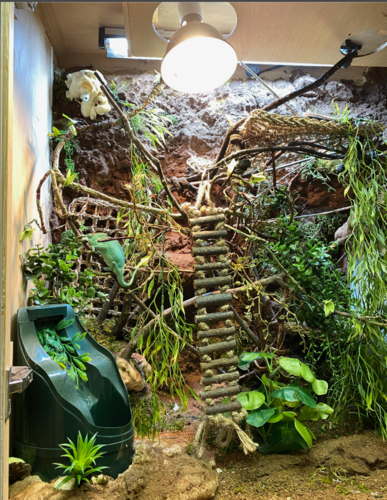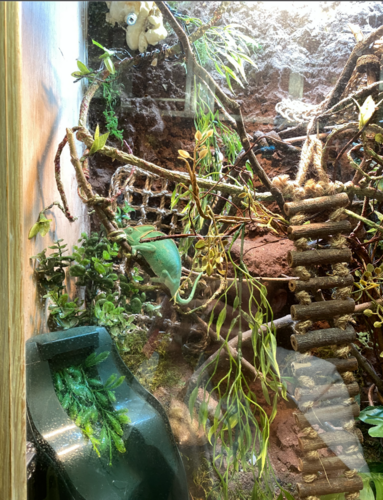no_dairy_jerry
New Member
Hi Everyone,
I am hoping for some tips on how to make my chameleon's life better. I have him in the garage because he is not allowed in the house. The main things I want to work on are heat, comfort, and taming. I have a humidifier that's on a timer and goes off about 5 times a day. The enclosure has glass doors and I have heard that mesh wire is better but I am concerned about the cage getting too cold and his humidity levels going down. It's getting colder here in the winter being in Nor California so I need a good heating solution to keep him warm at night so I don't need to leave his light on. Finally, I am wondering if anyone has tips for taming him. I have given him his space for about 3 months and only help him 3 times being very cautious each time and not pulling him out. I have tried getting him used to me by hand-feeding but even when I have a cricked he doesn't want to come near me. Is there any treats that might spark his interest to come out and say Hi. Thanks in advance for any tips of products you could recommend making his life happier.
Here is a video of his enclosure (and the pictures are below)
https://share.icloud.com/photos/0uyN-zfeXqzQgal0NtPA4IcHA
I am hoping for some tips on how to make my chameleon's life better. I have him in the garage because he is not allowed in the house. The main things I want to work on are heat, comfort, and taming. I have a humidifier that's on a timer and goes off about 5 times a day. The enclosure has glass doors and I have heard that mesh wire is better but I am concerned about the cage getting too cold and his humidity levels going down. It's getting colder here in the winter being in Nor California so I need a good heating solution to keep him warm at night so I don't need to leave his light on. Finally, I am wondering if anyone has tips for taming him. I have given him his space for about 3 months and only help him 3 times being very cautious each time and not pulling him out. I have tried getting him used to me by hand-feeding but even when I have a cricked he doesn't want to come near me. Is there any treats that might spark his interest to come out and say Hi. Thanks in advance for any tips of products you could recommend making his life happier.
Here is a video of his enclosure (and the pictures are below)
https://share.icloud.com/photos/0uyN-zfeXqzQgal0NtPA4IcHA








